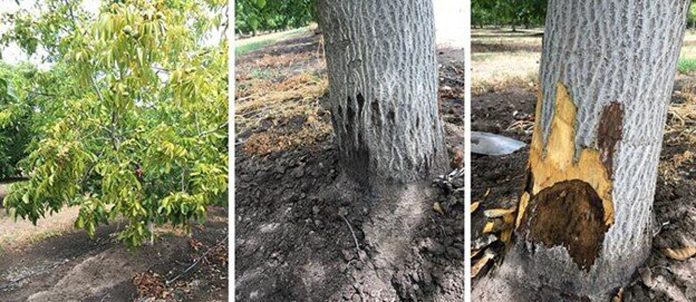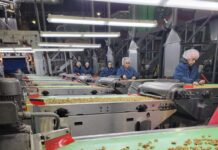
At first glance, the symptoms of Phytophthora root and crown rot and lethal Paradox canker disease in walnut trees (yellowing leaves, failure to thrive and ultimately tree death) may look similar. But peel back the bark, and the similarities end.
Paradox canker disease cankers tend to be more rounded or lobed at the edges, compared to the irregular margins of Phytophthora cankers. While researchers have pinpointed the cause of Phytophthora root and crown rot and have developed management recommendations, they have yet to determine the causal agent of Paradox canker.
“We know a lot about Phytophthora, but Paradox canker is a big question mark,” said Jaime Ott, UCCE orchard crops advisor for Shasta, Glenn, Butte and Tehama counties. “We’re looking at everything, for example, causation by an unknown pathogen, as well as hybrid incompatibility or environmental sensitivity.”
Her comments came during the recent Quad-County Walnut Institute in Stockton.
Seeking the Causal Agent
To learn more about Paradox canker disease and its cause, an interdisciplinary research team has been visiting orchards and sampling trees affected by the disease for more than a decade. Leading the effort is Greg Browne, a USDA-ARS research plant pathologist housed in the UC Davis Department of Plant Pathology. During the visits, team members collected samples of affected tissue, learned about visual symptoms that distinguish Paradox canker from Phytophthora crown rot and observed orchards for clues surrounding Paradox canker and potential management steps to avoid it.
The researchers used several methods to examine affected tissue collected from Paradox canker trees, Browne said. First, they placed bits of tissue in isolation media to detect agents associated with the disease. In some cases, they also used electron microscopy to examine infected tissue.
DNA and RNA extracted from affected tissue also were subjected to various methods that detect molecular “fingerprints” of potential causal agents, including those that might not be culturable, such as viruses.
Hossein Gouran, a post-doctoral associate in Browne’s laboratory in 2017, used DNA and RNA extracts for metagenomic and metatranscriptomic approaches, which typically are used to study specific microorganism communities. They also can be used to explore samples for molecular fingerprints of specific pathogen genomes and genes.
Finally, to find evidence of an infectious agent causing the disease, researchers completed graft transmission of Paradox canker symptoms. This involved taking bark disks from infected trees and grafting them onto healthy trees, said Ott, who had worked in Browne’s lab for eight years before joining UCCE earlier this year. Some of the healthy Paradox rootstock portions around the grafted disks became symptomatic, providing Browne and Ott with evidence that a transmissible agent may cause Paradox canker disease.
To date, Browne said, testing has not provided consistent evidence of the specific Paradox canker disease cause. More work is needed to pinpoint the disease agent, including fulfillment of Koch’s postulates, which are a series of steps that pathologists use to determine the cause of a disease, he said.
They include consistently isolating and identifying a suspected causal agent from plants showing disease symptoms. Researchers then inoculate healthy plants with the suspected agent to determine whether disease symptoms appear. At the same time, they compare the inoculated plants to non-inoculated controls.
From there, the researchers try to reisolate and identify the suspected causal agent from the inoculated symptomatic plants.
Bob Beede, who as a UCCE farm advisor in Kings County was one of the first to find what initially was dubbed unknown Paradox canker in 2007, said the inability to find a causal agent is not for lack of trying.
“Dr. Browne has to be given just a tremendous amount of credit for his tenacity to understand what this is,” said Beede, a farm advisor emeritus.
The Paradox Surrounding Clonal Rootstock
A hybrid of mainly Juglans hindsii and J. regia (Northern California black walnut crossed with an English walnut), Paradox rootstock has become popular because of the hybrid vigor it imparts to trees. In fact, more than 70% of the state’s commercial English walnut trees are grafted onto it.
So far, they’ve only found Paradox canker disease in trees grafted onto seedling Paradox rootstock, Ott said. And trees don’t seem to develop Paradox canker disease until they are well into crop-bearing years, typically eight years or older, she said. Surveys of walnut orchards on Paradox seedling rootstock have identified the canker disease in at least some orchards within all walnut-producing regions of the Central Valley, Browne said.
The current recommendation is to remove trees infected with Paradox canker, taking care not to spread diseased tissue in the orchard, Ott said. Although reset trees have not been observed succumbing to Paradox canker, they still are subject to replant pests, such as plant parasitic nematodes.

Whether trees grafted onto clonal Paradox rootstock, such as Vlach, RX1 and VX211, are susceptible is unknown since they are much newer, and many orchards using these rootstocks are just entering the vulnerable period, Ott said. So far, the malady has not been found in clonal Paradox trees, Beede said.
“Any time you have cloned something, you have now narrowed down the genetic pool,” he said. Browne agreed and said it was important to determine whether the clones are susceptible to Paradox canker because of the inherent genetic uniformity within them.
Beede recommended that growers and consultants scout for Paradox canker disease in orchards on clonal Paradox rootstock as they would any other disease.
Paradox Canker vs Phytophthora Crown Rot Cankers
Trees with Paradox canker may initially have yellowing leaves and loss of vigor. Visual evidence also includes black oozing of the bark extending from below the soil line up into the lower Paradox tree trunk, Beede said.
Distinguishing these symptoms from Phytophthora involves removing a patch of bark using a chisel and hammer to expose the canker in the woody tissue.
“If you see a tree that’s oozing something that looks like black crank case oil, don’t overlook it,” he said. “Investigate with a hammer and chisel to see what’s going on.”
While Phytophthora crown rot cankers typically have jagged edges, those of Paradox cankers generally have rounded lobes. New cankers extend from older, darker portions of the canker, giving what some researchers have described as resembling Mickey Mouse ears.
Eventually, the canker may envelop the rootstock. Based on surveys of orchards, researchers say infected trees usually die within a few years of symptom onset.
Beede recommended that growers or PCAs who suspect Paradox canker contact their local farm advisor to collect samples for further testing.
That said, Paradox canker has a low incidence within orchards, ranging from 1% to 6% in the most severe cases, based on surveys conducted by farm advisors and researchers. That compares to Phytophthora, which can take a much greater toll in orchards in severe instances.
Of the 200-plus members of the Phytophthora genus worldwide, a handful of species cause the bulk of problems in California walnuts, Ott said.
Phytophthora can be diagnosed by specialized laboratories using culture-based methods or by PCR testing of pathogen DNA.
Pears can be used as bait for Phytophthora species in soil samples. Within a couple days of exposure, the pear should begin to show lesions if Phytophthora spores are present.
However, pear baiting provides only indirect soil-based evidence for involvement of Phytophthora in tree infections; pear baiting results are useful but not definitive, Browne said. Currently, Paradox canker disease is diagnosed by its distinctive visual symptoms and lack of association with Phytophthora in symptomatic tissues.










